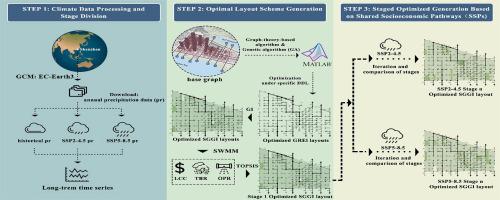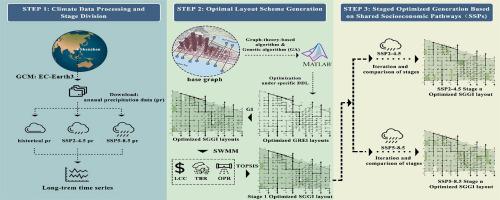基于共享社会经济路径的协同灰绿色基础设施应对长期气候变率的多阶段优化框架
IF 12.4
1区 环境科学与生态学
Q1 ENGINEERING, ENVIRONMENTAL
引用次数: 0
摘要
全球气候变化和快速城市化使极端降雨事件和地表径流日益加剧,给城市水文安全带来重大挑战。协同灰绿基础设施(SGGI)已被广泛应用于加强城市雨水管理。然而,目前的研究主要集中在单一降雨条件下灰色基础设施(GREI)或绿色基础设施(GI)的优化和评价,而忽略了长期气候变化对基础设施性能的非平稳影响。因此,本研究引入了一个基于共享社会经济路径的SGGI布局多阶段优化框架,利用图论和遗传算法,通过生命周期成本(LCC)和水力可靠性来确定应对不同气候变化情景的最优方案。以中国深圳为例,对该方法进行了验证。结果表明:(1)SSP2-4.5和SSP5-8.5情景下,深圳年降水序列存在显著的阶段性变化;(2)与GREI相比,优化的SGGI布局节省了大量的LCC,集中式和分散式策略分别减少了6.6%和4.7%。(3) SGGI对极端降雨条件的适应性从透水路面向生物滞留细胞转变;(4)在LCC控制和液压可靠性方面,Change-GREI&GI (CGG)策略始终优于Change-only-GI (COG)策略,特别是在极端情况下,成本优势为1.68%。这些发现强调了多阶段优化在提高灰绿色综合基础设施系统的成本效益和复原力方面的关键作用,为设计有效应对城市环境长期气候变化的适应性SGGI策略提供了有价值的见解。本文章由计算机程序翻译,如有差异,请以英文原文为准。


Multi-stage optimization framework for synergetic grey-green infrastructure in response to long-term climate variability based on shared socio-economic pathways
Global climate change and rapid urbanization have increasingly intensified extreme rainfall events and surface runoff, posing significant challenges to urban hydrological security. Synergetic Grey-Green Infrastructure (SGGI) has been widely applied to enhance stormwater management in urban areas. However, current research primarily focused on optimizing and evaluating either grey infrastructure (GREI) or green infrastructure (GI) under single rainfall event, neglecting the non-stationary impacts of long-term climate change on infrastructure performance. Therefore, this study introduced a multi-stage optimization framework for SGGI layouts based on shared socio-economic pathways, utilizing graph theory and genetic algorithms to identify optimal solutions through life cycle cost (LCC) and hydraulic reliability in response to varying climate change scenarios. A case study of Shenzhen, China, was conducted to validate this method. The results indicated that: (1) SSP2-4.5 and SSP5-8.5 scenarios revealed significant phase-specific variations in Shenzhen's annual precipitation series; (2) The optimized SGGI layouts yielded substantial LCC savings compared to GREI, with centralized and decentralized strategies achieving reductions of 6.6% and 4.7%, respectively. (3) The SGGI adapted to extreme rainfall conditions by shifting preference from permeable pavements to bioretention cells; (4) The Change-GREI&GI (CGG) strategy consistently outperformed the Change-only-GI (COG) strategy in LCC control and hydraulic reliability, particularly a 1.68% cost advantage under extreme scenarios. These findings highlight the critical role of multi-stage optimization in improving the cost-effectiveness and resilience of integrated grey-green infrastructure systems, providing valuable insights for designing adaptive SGGI strategies that effectively respond to long-term climate variability in urban environments.
求助全文
通过发布文献求助,成功后即可免费获取论文全文。
去求助
来源期刊

Water Research
环境科学-工程:环境
CiteScore
20.80
自引率
9.40%
发文量
1307
审稿时长
38 days
期刊介绍:
Water Research, along with its open access companion journal Water Research X, serves as a platform for publishing original research papers covering various aspects of the science and technology related to the anthropogenic water cycle, water quality, and its management worldwide. The audience targeted by the journal comprises biologists, chemical engineers, chemists, civil engineers, environmental engineers, limnologists, and microbiologists. The scope of the journal include:
•Treatment processes for water and wastewaters (municipal, agricultural, industrial, and on-site treatment), including resource recovery and residuals management;
•Urban hydrology including sewer systems, stormwater management, and green infrastructure;
•Drinking water treatment and distribution;
•Potable and non-potable water reuse;
•Sanitation, public health, and risk assessment;
•Anaerobic digestion, solid and hazardous waste management, including source characterization and the effects and control of leachates and gaseous emissions;
•Contaminants (chemical, microbial, anthropogenic particles such as nanoparticles or microplastics) and related water quality sensing, monitoring, fate, and assessment;
•Anthropogenic impacts on inland, tidal, coastal and urban waters, focusing on surface and ground waters, and point and non-point sources of pollution;
•Environmental restoration, linked to surface water, groundwater and groundwater remediation;
•Analysis of the interfaces between sediments and water, and between water and atmosphere, focusing specifically on anthropogenic impacts;
•Mathematical modelling, systems analysis, machine learning, and beneficial use of big data related to the anthropogenic water cycle;
•Socio-economic, policy, and regulations studies.
 求助内容:
求助内容: 应助结果提醒方式:
应助结果提醒方式:


